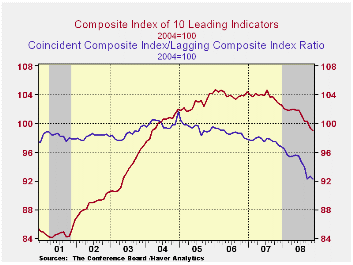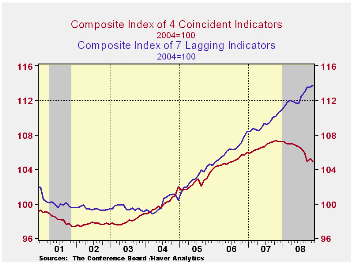 Global| Dec 18 2008
Global| Dec 18 2008U.S. Leading Indicators Continued Lower
by:Tom Moeller
|in:Economy in Brief
Summary
The Conference Board indicated that it's composite index of leading economic indicators fell during November by 0.4% after a slightly revised 0.9% October decline. The peak for the index was in July of last year and the six-month [...]

The Conference Board indicated that it's composite index of leading economic indicators fell during November by 0.4% after a slightly revised 0.9% October decline. The peak for the index was in July of last year and the six-month percent change fell to -5.6%, the largest rate of decline since 1990.
Six of the ten components of the leading index fell last month with the largest decline coming from building permits which alone subtracted 0.5% from the leading index. Higher initial claims for jobless insurance in addition subtracted 0.3% and lower stock prices subtracted 0.4%. Also down were weekly hours, vendor performance, and consumer expectations. A steeper yield curve and faster money supply growth together added back 1.0% to the index level.
The breadth of one-month increase amongst the leaders' 10 components improved slightly to 40% but over a six-month period the breadth of gain amongst the components remained quite low at 30%.
The leading index is based on actual reports for eight economic data series. The Conference Board initially estimates two series, orders for consumer goods and orders for capital goods.
The coincident indicators reversed the prior month's gain and fell 0.3%. Three quarters of the index components fell m/m but over six months 12.5% rose. Over the last ten years there has been an 86% correlation between the y/y changes in the coincident indicators and real GDP.
The lagging index ticked up 0.1% after no change in October. The ratio of coincident-to-lagging indicators (a measure of economic excess) fell back to its lowest level since 1975.Visit the Conference Board's site for coverage of leading indicator series from around the world.
| Business Cycle Indicators (%) | November | October | September | August 6-Month % (AR) | 2007 | 2006 | 2005 |
|---|---|---|---|---|---|---|---|
| Leading | -0.4 | -0.9 | 0.0 | -5.6 | -0.4 | 1.3 | 2.7 |
| Coincident | -0.3 | 0.3 | -1.0 | -3.5 | 1.7 | 2.4 | 2.5 |
| Lagging | 0.1 | 0.0 | 0.6 | 3.6 | 2.9 | 3.1 | 3.1 |
Tom Moeller
AuthorMore in Author Profile »Prior to joining Haver Analytics in 2000, Mr. Moeller worked as the Economist at Chancellor Capital Management from 1985 to 1999. There, he developed comprehensive economic forecasts and interpreted economic data for equity and fixed income portfolio managers. Also at Chancellor, Mr. Moeller worked as an equity analyst and was responsible for researching and rating companies in the economically sensitive automobile and housing industries for investment in Chancellor’s equity portfolio. Prior to joining Chancellor, Mr. Moeller was an Economist at Citibank from 1979 to 1984. He also analyzed pricing behavior in the metals industry for the Council on Wage and Price Stability in Washington, D.C. In 1999, Mr. Moeller received the award for most accurate forecast from the Forecasters' Club of New York. From 1990 to 1992 he was President of the New York Association for Business Economists. Mr. Moeller earned an M.B.A. in Finance from Fordham University, where he graduated in 1987. He holds a Bachelor of Arts in Economics from George Washington University.






